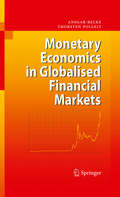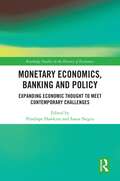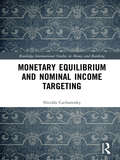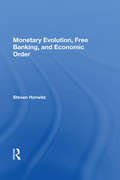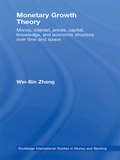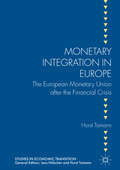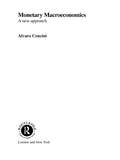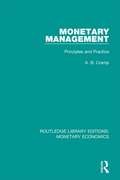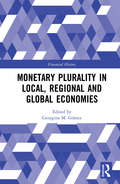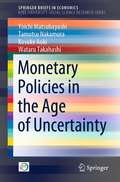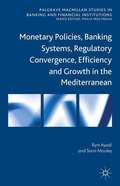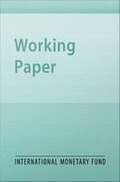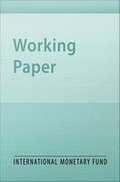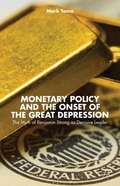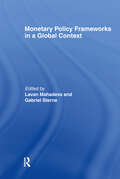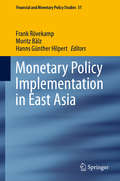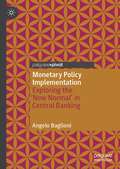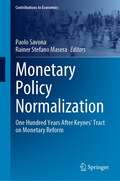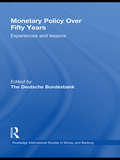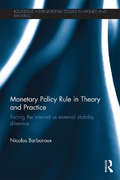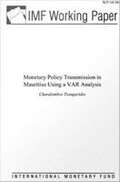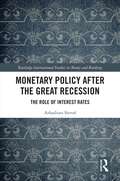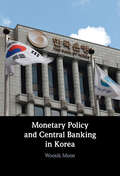- Table View
- List View
Monetary Economics in Globalised Financial Markets
by Ansgar Belke Thorsten PolleitThis book integrates the fundamentals of monetary theory, monetary policy theory and financial market theory, providing an accessible and comprehensive introduction to the many-sided interrelations between these fields of research. It provides the reader with the intellectual groundwork indispensable for understanding the workings and interactions of today's globalised financial markets. The topics addressed in this book include, inter alia, alternative money supply regimes, money demand functions, monetary policy transmission, monetary policy effectiveness and the natural rate of unemployment, monetary political business cycles, and monetary policy strategies. Basic valuation models for stocks, and bonds and asset price linkages across currency areas are covered as well. Illustrated by carefully chosen examples and supported by extensive data analyses, this book is highly recommended to readers who seek an in-depth and up-to-date integrated overview about the ever-expanding theoretical and quantitative fields of monetary and financial economics.
Monetary Economics, Banking and Policy: Expanding Economic Thought to Meet Contemporary Challenges (Routledge Studies in the History of Economics)
by Ansgar Lyssy Penelope HawkinsThis edited collection seeks to advance thinking on money and the monetary nature of the economy, macroeconomic analysis and economic policy, setting it within the context of current scholarship and global socioeconomic concerns, and the crisis in the economics discipline. A key aim is to highlight the central contribution that Sheila Dow has made to these fields. Bringing together an impressive panel of contributors, this volume explores topics including central bank independence, liquidity preferences, money supply endogeneity, financial regulation, regional finance and public debt. The essays in this collection will be thought-provoking reading for advanced students and scholars of macroeconomics, monetary economics, central banking and heterodox economics. Contributors have a broad range of professional experience at universities, central banks, business, development institutions and policy advisories.
Monetary Equilibrium and Nominal Income Targeting (Routledge International Studies in Money and Banking)
by Nicolás CachanoskyThis book examines the case of nominal income targeting as a monetary policy rule. In recent years the most well-known nominal income targeting rule has been NGDP (level) Targeting, associated with a group of economists referred to as market monetarists (Scott Sumner, David Beckworth, and Lars Christensen among others). <P><P> Nominal income targeting, though not new in monetary theory, was relegated in economic theory following the Keynesian revolution, up until the financial crisis of 2008, when it began to receive renewed attention. This book fills a gap in the literature available to researchers, academics, and policy makers on the benefits of nominal income targeting against alternative monetary rules. <P><P> It starts with the theoretical foundations of monetary equilibrium. With this foundation laid, it then deals with nominal income targeting as a monetary policy rule. What are the differences between NGDP Targeting and Hayek’s rule? How do these rules stand up against other monetary rules like inflation targeting, the Taylor rule, or Friedman’s k-percent? <P><P> Nominal income targeting is a rule which is better equipped to avoid monetary disequilibrium when there is no inflation. Therefore, a book that explores the theoretical foundation of nominal income targeting, comparing it with other monetary rules, using the 2008 crisis to assess it and laying out monetary policy reforms towards a nominal income targeting rule will be timely and of interest to both academics and policy makers.
Monetary Evolution, Free Banking, And Economic Order
by Steven HorwitzThis book deals with the origin and functions of money and banking, emphasizing the role both play in the promotion of economic order. Developing the insights of Hayek and others of the Austrian tradition, Professor Horwitz argues that an appreciation of the spontaneous evolutionary processes that produce and maintain our monetary institutions shou
Monetary Growth Theory: Money, Interest, Prices, Capital, Knowledge and Economic Structure over Time and Space (Routledge International Studies In Money And Banking Ser.)
by Wei-Bin ZhangThis book answers some challenging questions in monetary growth theory within a compact theoretical framework. The author succeeds in integrating the theory of money, the theory of value and the theory of growth. The book re-examines many important ideas in modern monetary economics within a single analytical framework. It is concerned not only wit
Monetary Integration in Europe
by Horst TomannThis book depicts the European Economic and Monetary Union against the historical background of different monetary regimes and pays special attention to the economic debate which accompanied the evolution of this currency area. The debate is still going on as to whether the European Economic and Monetary Union can survive as an institution providing the highest degree of monetary integration - a single monetary policy - for a group of member countries with divergent economic performance. The analysis of this question points at the need for new forms of economic policy coordinaton. This book explores the problems of policy coordination that arise within a monetary union and provides an overview of the basic issues and current controversial debates. The book is an excellent resource for academics with an interest in the European Economic and Monetary Union, and in economic policy coordination within Europe.
Monetary Macrodynamics (Routledge Frontiers Of Political Economy Ser.)
by Peter Flaschel Carl Chiarella Toichiro Asada Reiner FrankeThis book investigates the interaction of effective goods demand with the wage-price spiral, and the impact of monetary policy on financial and the real markets from a Keynesian perspective. Endogenous business fluctuations are studied in the context of long-run distributive cycles in an advanced, rigorously formulated and quantitative setup. The material is developed by way of self-contained chapters on three levels of generality, an advanced textbook level, a research-oriented applied level and on a third level that shows how the interaction of real with financial markets has to be modelled from a truly integrative Keynesian perspective. Monetary Macrodynamics shows that the balanced growth path of a capitalist economy is unlikely to be attracting and that the cumulative forces that surround it are controlled in the large by changes in the behavioural factors that drive the wage-price spiral and the financial markets. Such behavioural changes can in fact be observed in actual economies in the interaction of demand-driven business fluctuations with supply-driven wage and price dynamics as they originate from the conflict over income distribution between capital and labour. The book is a detailed critique of US mainstream macroeconomics and uses rigorous dynamic macro-models of a descriptive and applicable nature. It will be of particular relevance to postgraduate students and researchers interested in disequilibrium processes, real wage feedback channels, financial markets and portfolio choice, financial accelerator mechanisms and monetary policy.
Monetary Macroeconomics: A New Approach (Routledge International Studies In Money And Banking #Vol. 15)
by Alvaro CenciniThis book provides the grounding for a new approach to monetary economics, based on the book-keeping nature of money. The main themes of macroeconomics are examined to show how we may improve our understanding through a thorough analysis of their monetary aspects. Money is the key element and its role is investigated in relation to value, prices, p
Monetary Management: Principles and Practice (Routledge Library Editions: Monetary Economics #2)
by A. B. CrampThe aim of this book, first published in 1971, is to give the student of monetary economics a clear understanding of the theoretical potentialities of monetary policy as well as the practical limitations that prevent these potentialities from being realised. This volume discusses the central bank’s operations in both long- and short-term financial markets, the effects of foreign inflows and outflows of funds, the implications of government budgetary policy, and the repercussions of the activity of non-bank financial institutions. Monetary Management should be of interest to students of finance and to all those concerned by controversies about the operation of monetary policy.
Monetary Plurality in Local, Regional and Global Economies (Financial History)
by Georgina M. GómezThe idea that each country should have one currency is so deeply rooted in people’s minds that the possibility of multiple and concurrent currencies seems unthinkable. Monetary systems contribute to problems of high unemployment and social distress during financial and economic crisis, so reforms to increase the responsiveness and flexibility of the monetary system can be part of the solution. This book discusses ‘monetary plurality’, which is the circulation of several currencies at the same time and space. It addresses how multiple currency circuits work together and transform socio-economic systems, particularly by supporting economies at the local level of regions and cities. The book shows that monetary plurality has been ubiquitous throughout history and persists at present because the existence of several currency circuits facilitates small-scale production and trade in a way that no single currency can accomplish on its own. Monetary plurality can improve resilience, access to livelihoods and economic sustainability. At the same time, it introduces new risks in terms of economic governance, so it needs to be properly understood. The book analyses experiences of monetary plurality in Europe, Japan, and North and South America, written by researchers from East and West and from the global North and South. Replete with case studies, this book will prove a valuable addition to any student or practitioner’s bookshelf.
Monetary Policies in the Age of Uncertainty (SpringerBriefs in Economics)
by Tamotsu Nakamura Yoichi Matsubayashi Kosuke Aoki Wataru TakahashiThis book provides an interesting review of Japanese monetary policies after the bubble economy. The Bank of Japan was the first central bank in advanced economies to implement the unconventional monetary policies during the period. After the Lehman shock, most advanced economies also carried out similar monetary policies to boost their own economies. The Japanese experience in the 1990s and 2000s no doubt played a key role during the period. Although various aspects of the experiences have been examined, not many books have been published based on intensive discussions between the macro and monetary theorists who have been active in academics and the practitioners who have actually been involved in monetary policy. This small but important book has focused on the Japanese experience. Evaluation of that experience found that three solid pillars are of crucial importance: theory, institution, and experience. Those form the basis of the book, without theory, no policies will be formulated and implemented, and implementation depends crucially on institution. Chapter 1 provides a clear theoretical background for the unconventional monetary policies and inflation targeting. Chapter 2 intensively explores the meaning and desirability of the independence of central banks. Chapter 3 reviews the consequences of the Japanese monetary policies in recent decades in comparison with those in other advanced economies.
Monetary Policies, Banking Systems, Regulatory Convergence, Efficiency And Growth In The Mediterranean
by Rym Ayadi Sami MouleyMonetary Policy, central banking, and international norms and regulations; a discussion far from new, nor applying exclusively to the world's most advanced economies. A sound monetary policy and a well-enforced regulatory regime is provided, in explanation of developing nations to channel financial resources more efficiently into investments.
Monetary Policy Analysis and Forecasting in the Group of Twenty: A Panel Unobserved Components Approach
by Francis VitekA report from the International Monetary Fund.
Monetary Policy Analysis and Forecasting in the World Economy: A Panel Unobserved Components Approach
by Francis VitekA report from the International Monetary Fund.
Monetary Policy And The Onset Of The Great Depression The Myth Of Benjamin Strong As Decisive Leader
by Mark TomaMonetary Policy and the Onset of the Great Depression challenges Milton Friedman and Anna Schwartz's now consensus view that the high tide of the Federal Reserve System in the 1920s was due to the leadership skills of Benjamin Strong, head of the Federal Reserve Bank of New York.
Monetary Policy Frameworks in a Global Context (CENTRAL BANK GOVERNOR'S SYMPOSIUM)
by Mahadeva Lavan Sterne GabrielThis broad-ranging collection assesses the links between targets and central bank independence, accountability and the transparency of monetary policy. Renowned experts contribute to this original and comprehensive text which will be of great value to professional economists and students of economics and banking alike.Monetary Policy Frameworks in a Global Context was named Book of the Year, 2000 by Central Banking journal
Monetary Policy Implementation in East Asia (Financial and Monetary Policy Studies #51)
by Frank Rövekamp Moritz Bälz Hanns Günther HilpertThis book shares essential insights into the implementation of monetary policy in various East Asian countries. Highlighting case studies from China, Taiwan, Korea, Japan and Singapore, leading economists and practitioners from central banks illustrate how dependent effective monetary policy is on the institutional and financial market environment, as well as on successful implementation and communication. The respective contributions cover various aspects of monetary policy implementation, such as: How is inflation targeting handled? For what purposes and how do central banks operate on financial markets, and what are the (at times unintended) effects? How do currency market interventions help achieve the monetary policy targets set by individual countries or areas? In addition, Asian experiences are contrasted with those from the Eurozone.
Monetary Policy Implementation: Exploring the 'New Normal' in Central Banking
by Angelo BaglioniThis book addresses the implementation of monetary policy (MP) and focuses on the operations used by the central banks to implement their policies: the so-called operational framework of MP. The operational framework has become of paramount importance in the last fifteen years, due to the profound transformations taking place in this period. The financial crisis, started in August 2007, has rapidly changed the way in which MP is implemented around the world. Further, innovations have been introduced to address other crises in the following years: a new set of “unconventional” instruments have been adopted, like the large-scale purchases of private and government securities and the long-term refinancing operations. The balance sheets of central banks have increased by huge amounts. The recent surge of inflation has induced several central banks to exit those exceptional policies. However, instead of going back to the traditional “interest rate steering” approach, they are going towards a “new normal” that combines some features of that approach with others inherited from the “quantitative easing” experience. The book therefore addresses the following questions: Which are the common stylized patterns of the unconventional MP across the different countries? Did the economic profession work out a theoretical framework within which to place the unconventional MP? Which are the issues related to the exit strategy from unconventional MP? Which are the main features of the operational framework under the “new normal” approach? This book answers these questions by looking at the experiences of the European Central Bank, the Federal Reserve System alongside other central banks, and providing some original modelling and empirical evidence, which will be of interest to academics, researchers in banking and finance, policy makers, and practitioners in the financial industry.
Monetary Policy Normalization: One Hundred Years After Keynes' Tract on Monetary Reform (Contributions to Economics)
by Paolo Savona Rainer Stefano MaseraIn light of the pickup of inflation at the end of 2021 and monetary policy shifts by the world's major central banks, this book examines interrelated issues in the normalization of monetary policy. It covers topics including the role of technological innovations such as derivatives and cryptocurrencies in monetary and financial management, the role of monetary policy in financial crises (especially public debt), and the major repricing needed for central banks and the global economy. In addition, the book discusses the problem of how flexible money should be and the importance of predictive tools for these decisions, with attention to the advances of languages for scientific research, including those on the workings of the economy. The work addresses the geopolitical and social challenges that have arisen as a result of the invasiveness of monetary policy in its various manifestations in the context of major leading currencies. It is aimed at scholars and students of monetary and financial economics.
Monetary Policy Over Fifty Years: Experiences and Lessons (Routledge International Studies in Money and Banking)
by The Deutsche BundesbankThis book is based on a conference celebrating the 50th anniversary of the Deutsche Bundesbank. Since the 1950s, there have been fundamental changes in the monetary order and financial systems, in our understanding of the effects of monetary policy, the best goals for central banks and the appropriate institutional setting of central banks. Prominent monetary economists and central bankers give their views on the most significant developments during this period and the lessons we should draw from them. The book contains four sections on central issues. The first part discusses the main successes and failures of monetary policy since the 1950s. The second part asks what economists have learned about monetary policy over the past 50 years. It gives an overview on experiences with various monetary strategies, focusing in particular on monetary targeting and its problems, on inflation targeting and why it was successful and the institutional framework for monetary policy. The next section outlines the progress that monetary economists have made since the Bundesbank was founded and discusses the extent to which central banks can rely on "scientific" principles. The final part describes the interaction between monetary policy, fiscal policy and labour markets. The book provides a comprehensive overview of the main challenges faced by central bankers in the past and how and to what extent monetary economics have been helpful in tackling them. It outlines our current knowledge about the effects of monetary policy and the appropriate institutional framework for central banks and raises some open questions for the future. It will be of great interest to monetary economists, central bankers and economic historians.
Monetary Policy Rule in Theory and Practice: Facing the Internal vs External Stability Dilemma (Routledge International Studies in Money and Banking #78)
by Nicolas BarbarouxThis new volume sheds new light on current monetary issues, in particular the debate on monetary policy making, by blending theoretical economic analysis, history of economics, and historical case studies. A discretionary monetary policy refers to cases in which the central bank is free to change its policy actions or key instruments when the need arises, whilst a monetary policy rule can be defined as a commitment from (independent) central banks to reach one or several objective(s) by way of systematic policy actions. This book uses case studies from France and Sweden, and places them in the context of Keynes’ argument from his 1923 ‘Tract on Monetary Reforms’, to support the argument that the use of discretionary practices within a monetary policy rule (such as in the Gold Standard era) is the best approach. This book takes an innovative approach in combining a theoretical analysis (mainly the work of New Neoclassical Synthesis throughout Woodford's model) a history of economic thought analysis (based on the monetary works from Wicksell, Cassel and Keynes) and an historical study of central bank practices both in France (based on Bank of France archives materials) and in Sweden. The final section of the book explores the debate on monetary policy rule in light of the 2008 financial crisis. As such, the book provides a unique synthesis that will be of interest not only to scholars of history of economic thought and economic theory, but also to anyone with an interest in monetary economics and contemporary monetary policy.
Monetary Policy Transmission in Mauritius Using a VAR Analysis
by Charalambos TsangaridesA report from the International Monetary Fund.
Monetary Policy after the Great Recession: The Role of Interest Rates (Routledge International Studies in Money and Banking)
by Arkadiusz SierońWalter Bagehot noticed once that “John Bull can stand many things, but he cannot stand two per cent.” Well, for several years, he has had to stand interest rates well below that, in some countries even below zero. However, despite this sacrifice, the economic recovery from the Great Recession has been disappointingly weak. This book’s aim is to answer this question. The central thesis of the book is that the standard understanding of the monetary transmission mechanism is flawed. That understanding adopts erroneous assumptions—such as, that low interest rates always stimulate economic growth by boosting the credit supply, investment, and consumption—and does not fully take into account several unintended channels of monetary policy, such as risk-taking, high level of debt, or zombification of the economy. In other words, the effectiveness of monetary policy is limited during economic downturns accompanied by the debt overhang and the balance sheet recession, and generates negative effects, which can make the policy counterproductive. The author provides a thorough analysis of the issues related to the interest rates in the conduct of monetary policy, such as the risk-taking channel of monetary policy, the portfolio-balance channel and the wealth effect, zombie firms in the economy, the misallocation of resources, as well as the neutral interest rate targeting and the difference between the neutral and natural interest rate and the negative interest rate policy. The book is written in an accessible and engaging manner and will be a valuable resource for scholars of monetary economics as well as readers interested in (unconventional) monetary policy.
Monetary Policy and Central Banking in Korea
by Woosik MoonThis study is among the first to examine the theory and practice of monetary policy in South Korea. Woosik Moon provides a detailed analysis of the central bank of South Korea, one of the most successful and important economies in Asia. He covers everything from monetary policy to inflation targeting and macroprudential regulation, explaining how these policy tools were used to deal with the aftermath of the 2007-2011 financial crisis. He then brings his study into our current moment, speculating as to how the use of these policies will change in order to deal with the fallout of the Covid-19 pandemic. This book offers in-depth investigations and the provision of the most up-to-date information about the Bank of Korea's monetary and financial actions, serving as essential reading for central bankers and professionals of financial markets around the world, as well as anyone interested in monetary policy-making.
